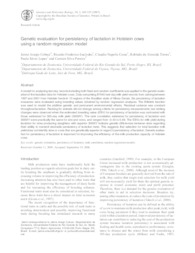Genetic evaluation for persistency of lactation in Holstein cows using a random regression model.
Genetic evaluation for persistency of lactation in Holstein cows using a random regression model.
Autoria: COBUCI, J. A.; EUCLYDES, R. F.; COSTA, C. N.; TORRES, R. de A.; LOPES, P. S.; PEREIRA, C. S.
Resumo: A model for analyzing test day records including both fixed and random coefficients was applied to the genetic evaluation of first lactation data for Holstein cows. Data comprising 87045 test-day milk yield records from calving between 1997 and 2001 from Holstein herds in 10 regions of the Brazilian state of Minas Gerais. Six persistency of lactation measures were evaluated using breeding values obtained by random regression analyses. The Wilmink function was used to model the additive genetic and permanent environmental effects. Residual variance was constant throughout lactation. Ranking for animals did not change among criteria for persistency measurements, but ranking changes were observed when the estimated breeding value (EBV) for persistency of lactation was contrasted with those estimated for 305-day milk yield (305MY). The rank correlation estimates for persistency of lactation and 305MY were practically the same for sire and cows, and ranged from -0.45 to 0.69. The EBVs for milk yield during lactation for sires producing daughters with superior 305MY indicate genetic differences between sires regarding their ability to transmit desirable persistency of lactation traits. This suggests that selection for total lactation milk yield does not identify sires or cows that are genetically superior in regard to persistency of lactation. Genetic evaluation for persistency of lactation is important for improving the efficiency of the milk production capacity of Holstein cows.
Ano de publicação: 2007
Tipo de publicação: Artigo de periódico
Unidade: Embrapa Gado de Leite
Palavras-chave: Genetic evaluation, persistency of lactation, random regression models, rank correlation
Observações
1 - Por padrão são exibidas publicações dos últimos 20 anos. Para encontrar publicações mais antigas, configure o filtro ano de publicação, colocando o ano a partir do qual você deseja encontrar publicações. O filtro está na coluna da esquerda na busca acima.
2 - Para ler algumas publicações da Embrapa (apenas as que estão em formato ePub), é necessário ter, no celular ou computador, um desses softwares gratuitos. Sistemas Android: Google Play Livros; IOS: iBooks; Windows e Linux: software Calibre.
Acesse outras publicações
Acesse a Base de Dados da Pesquisa Agropecuária (BDPA) para consultar o acervo completo das bibliotecas da Embrapa.

